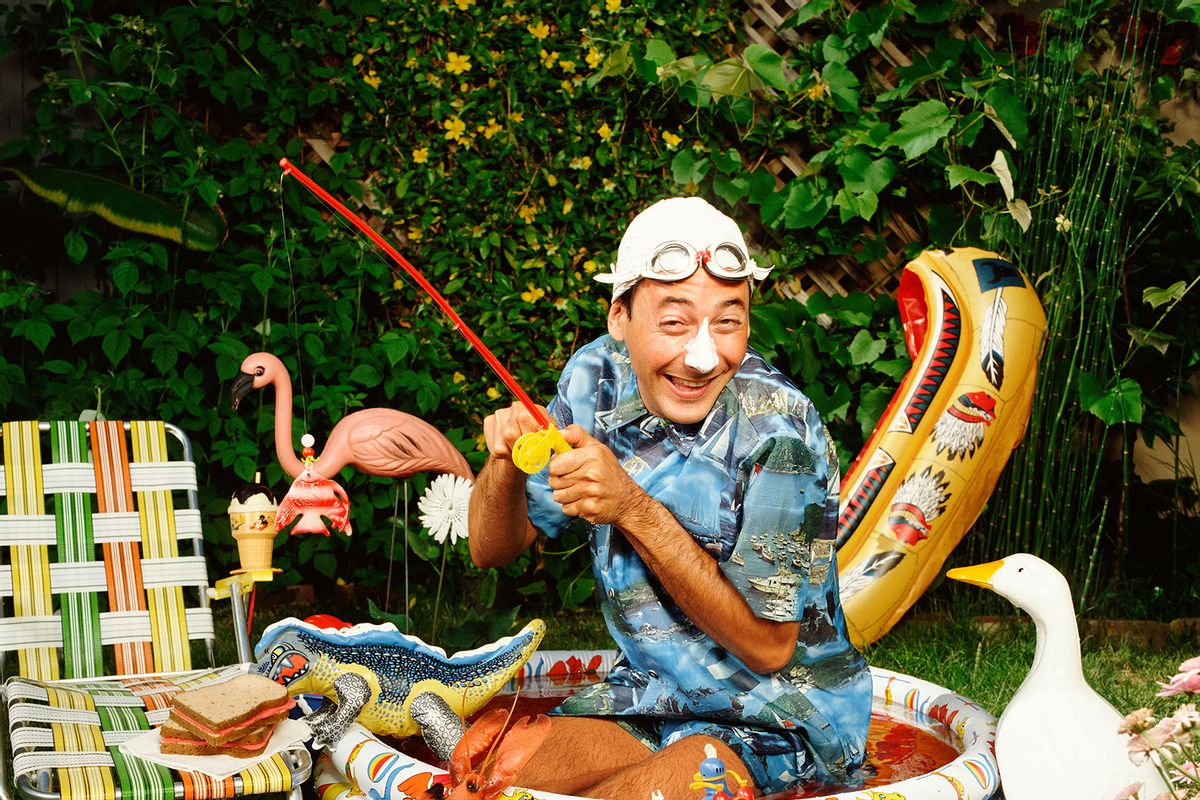“Larger than life, but still true”: Where Pee-wee Herman fits in the history of American clowns

At the beginning of the 1988 film “Big Top Pee-wee,” the circus blows into town — literally, thanks to a wind-whipping storm — and lands on none other than Pee-wee Herman’s farm. Pee-wee (Paul Reubens), who works the farm in the same slim gray glen plaid suit and red bow tie that became his uniform in the Playhouse, is, of course, delighted. He greets the performers with his patented brand of childlike whimsy and perpetual optimism, punctuated by a few hand flutters thrown in for good measure.
It’s no surprise that Pee-wee quickly decides that he wants to join the circus because to anyone who’s watching, it’s clear that’s where he belongs. Ringleader Mace Montana (Kris Kristofferson) sees it, too, telling him that he has “sawdust in his veins.” The crotchety townspeople who are distrustful of colorful outsiders? Eh, not so much.
After being told to pack up their tents and go, Mace confides in Pee-wee. “I don’t know what to make of it, kid,” he says as he slowly leads the caravan away from town. “When people don’t want a circus, the world just doesn’t make sense.”
“What do you mean, Mace?” Pee-wee asks.
Mace simply, and almost sadly, answers: “I’m a guy who has spent most of his life taking the world’s frown and trying to turn it into a smile.”
And while Mace is the one doing the talking in this scene, it was Reubens (along with fellow Groundlings alum George McGrath) who wrote it, and following the news of his death at the age of 70 this week, those simple lines take on new resonance because they feel autobiographical.
When assessing the legacy of Paul Reubens, it’s worth remembering that he wasn’t just Pee-wee Herman. He was one of the world’s greatest contemporary clowns.
Before you completely recoil from the page, I get it. Clowns don’t have the best reputation in American pop culture. If they’re not portrayed as an alcoholic kid’s party performer — think Bobcat Goldthwait’s “Shakes the Clown” — there’s always the killer clown trope, popularized by DC comics and Pennywise and then, unfortunately, made all too real by people like John Wayne Gacy and Wrinkles the Clown, a “performance artist” whom Florida parents would call to scare their kids straight for “a few hundred dollars.”
But the definition of clowning is both broader and more historic than that. As Linda Rodriguez McRobbie wrote for Smithsonian Magazine in 2013:
Clowns, as pranksters, jesters, jokers, harlequins, and mythologized tricksters have been around for ages. They appear in most cultures — Pygmy clowns made Egyptian pharaohs laugh in 2500 BCE; in ancient imperial China, a court clown called YuSze was, according to the lore, the only guy who could poke holes in Emperor Qin Shih Huang’s plan to paint the Great Wall of China; Hopi Native Americans had a tradition of clown-like characters who interrupted serious dance rituals with ludicrous antics. Ancient Rome’s clown was a stock fool called the ‘stupidus’; the court jesters of medieval Europe were a sanctioned way for people under the feudal thumb to laugh at the guys in charge; and well into the 18th and 19th century, the prevailing clown figure of Western Europe and Britain was the pantomime clown, who was a sort of bumbling buffoon.
In terms of later circus clowns, there are a few main types. There’s the whiteface clown, with traditional ruffled collars and pointed hats; the auguste, or red clown, is the one who, according to Clownopedia, “normally takes the pie in the face or the bucket of water from the whiteface.”
And then, there are the character clowns, which is where Reuebens fits in with a long line of comedic performers.
One of the most recognizable character clowns of the American circus was a “hobo” or “tramp clown,” like Red Skelton’s Hobo Freddie the Freeloader, complete with a painted-on 5 o’clock shadow that could be seen from the cheap seats. However, character clowns could be exaggerated versions of anyone: grandmothers (like Big Apple Circus’ now-disgraced Barry Lubin), butchers, bakers, police officers or, in the case of Reubens’ Pee-wee, a boy who never really grew up.
It’s worth noting, as well, that the creation of Pee-wee as a character is rooted in circus history. In a 2004 conversation with “Fresh Air” host Terry Gross, Reubens discussed the development of Pee-wee’s iconic voice.
“I worked at a theater that was the state theater of Florida called the Oslo Theater, which is still in existence, still a fantastic place, which was in my hometown, Sarasota, Florida, and was based at the John and Mable Ringling Museum of Art, which Sarasota, as you may or may not know, was the former [winter] headquarters of the Ringling Brothers Circus, so there’s a lot of Ringling influence there,” Reubens said.
He explained that while spending a few months playing the second oldest son (“not the star son, the second-banana son”) in “Life with Father” his character gradually developed into something of a cartoon.
“There’s a lot of Ringling influence there.”
“So the voice came from that. That is Pee-Wee’s voice. It was from, you know, ‘Good morning, mother,’ you know, blah, blah, blah,” he said. “And that became Pee-Wee’s voice. I love that story.”
Gregory Maupin is a Louisville-based actor who is a graduate of Dell’Arte International School of Physical Theatre and works, as he describes, “mainly in the worlds of physical comedy, clown and Shakespeare.” He said that while there are wildly different definitions of performance style when it comes to clowns, most include some version of a “character that’s far larger than life, but true.”
“There are all kinds of trappings that go with that — physical gestures and responses and silhouettes that are cartoonishly exaggerated yet, again, true,” Maupin said, before suggesting that examples may be better. He pointed to a lot of Gilda Radner’s characters; the silent films of Keaton, Chaplin, Lloyd; the stage work of Bill Irwin, Avner Eisenberg, Jeff Raz and the late Joan Mankin.
According to Maupin, there is something Wile E. Coyote-esque about these characters. They often fail over and over again in similar ways. A sample gag could include someone tripping over a rock and angrily kicking it down the road, only to trip over it again. When they finally succeed, it’s despite, not because of, their efforts.
“In the best cases they remind us of our own constant failure, but also that everyone else is constantly failing, too,” Maupin said. “That’s the most concise way I can think to put it. To put Reubens’s Pee-wee in there, he was just so constantly present and capricious and avoided the ‘Little Single Tear’ even when he danced up close to it.”
“Pee-wee was so much more real. So consistent but still unpredictable. The best clowns have emotions like a kitten has intestines — it all goes straight through them”
Maupin acknowledges that childlike characters are difficult to pull off because they can come across as exhaustingly chaotic or cloyingly sentimental — a common criticism of the Pee-wee Herman character from those who weren’t fans.
“But Pee-wee was so much more real. So consistent but still unpredictable,” Maupin said. “The best clowns have emotions like a kitten has intestines — it all goes straight through them — and he had that Puckish thing that’s hard to make people stick around for sometimes if it’s, again, done in a way that’s tiring instead of energizing.”
Maupin continued: “But people who are good at it make it transcend standard human behavior.”
That’s certainly how it feels rewatching Reubens in his 1981 stage special “The Pee-wee Herman Show,” which was recorded by HBO after it played for five sellout months at The Roxy Theatre in Los Angeles. It was filmed five years before “Pee-Wee’s Playhouse” would eventually air on CBS, stripped of some of the sexual innuendo that made the original stage show a midnight classic among slightly rowdy adults.
With his props — a wind-up spider, a “naked Gumby,” a gigantic pair of underwear — and fellow performers, from the beautiful Miss Yvonne (Lynne Marie Stewart) to Captain Carl (SNL alum Phil Hartman), Reubens is electric.
To borrow Maupin’s line about the art of being a clown, everything about the Playhouse, with its gigantic talking clock and genie in a box, is larger than life. But somehow, against all odds, Reubens manages to make it all feel true. So, at the end of the night, when he finally gets his chance to fulfill his lifelong wish of flying, there’s no reason to believe that he can’t.
Read more
about this topic


